One of the tougher challenges about the HTC Trophy running Windows Phone is the battery life. Having been a bit shocked at the short battery life while flying to New York, I made sure to top up the Trophy for twenty minutes or so on either a laptop or a portable battery charger (in this case my well-used Proporta USB Turbocharger) around lunchtime each day. This, coupled with the natural rhythm of a conference of sessions, mixed in with prowling the hallways, was enough to make it last through a day's work - but not enough to survive being out to the night-time events. Another top-up charge, this time in my pocket on the walk between the venues, gave enough battery life to make it. Disappointing (especially as the E7 was still trundling along showing four bars) but I guess this is the way of the smartphone now.

Part of the hit on the battery is the demand of Windows Phone to be updating status messages of your friends, staying in touch with "the cloud", and generally treating itself as an always-connected smartphone (an issue I touched on in part one of this series). Someone really needs to sort out a central app on the handset to configure updates and online syncing with ease, or sort out roaming data charges so I can go abroad and not worry about how much damage 12MB a day of light usage will do to my bill. Or should we expect to spend the first morning of any trip hunting down a Pay as You Go card because very few people carry a Filofax full of foreign SIMs?
Anyway, there's a slightly more awkward problem with Windows Phone going online, and that's maintaining a wi-fi connection - specifically with the conference wi-fi. This required a log-in via a web-page (similar to paying for your wi-fi at a hotspot) before you could start browsing. Let's just say that throughout the conference I became very familiar with the login page to the wi-fi at the Jacob Javits Conference Centre, because the Windows Phone would not stay connected, or at least remember the session.
I suspect this is down to the lack of background tasks and a closing web browser taking away a cookie or something similar. No matter the cause in code, the issue is still there. I checked my E7 during the Conference as well (I might be testing in the real world, but I always carry a safety net in case of emergencies) and that held on to the wi-fi and stayed connected for the whole time with one login.
I mentioned the rhythm of the conference, and there was a certain rhythm while I was using Windows Phone as well, especially when social media interaction is concerned. Assuming that each conference session is going to hold my attention (and if not, it would be smart to move on to another one rather than complain about it on Twitter), the time between the sessions is when the bulk of any browsing and searching online is done.
Which meant that as I was coming out of each session, there a check on the email client, on Twitter, on Facebook, and I take it from there. Now I could set up the Email client to sync after a specific timeframe (so not strictly push email, but a regular polling) but again I have a concern about battery life and having it trigger off an email download while on a cellular data connection. Perhaps I am too used to the safety net of "download headers only" on the Symbian client, but this is one of many occasions where you have an "all or nothing" approach to connectivity.
When you slim down a user interface, this is what you get, though. The choice is to either provide a bundle of settings (even under an 'advanced' box) for the power users, or strip this out so the other 90% of users won't get scared. It's a decision that doesn't allow compromise, and with smartphones firmly targeted at the mass market, these simpler choices will always be made, even to the detriment of other areas.
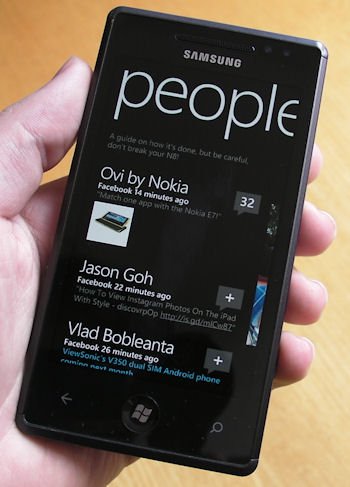
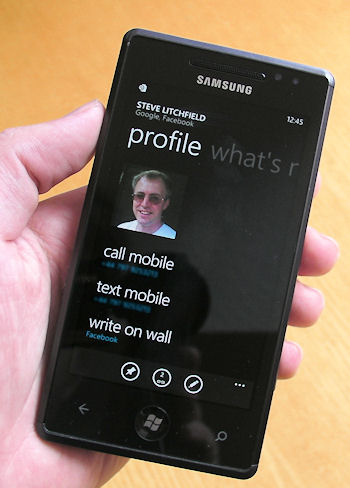
One of the big sells of Windows Phone is how it integrates into a number of social networks - while Twitter isn't due until the big 'Mango' update later in the year, Facebook is already in the smartphone, giving you access to all your friends and their activity in the People hub. This is one of the most impressive features of Windows Phone to me, and goes some way to the promise of a unified address book. Taking in details from Windows Live and Facebook, it is automatically populated when you set up the phone.
That means checking recent status messages from friends on Facebook, as well as updating my own (and reading comments on my updates) is built into the OS, and is a swipe or two away. It's good for dipping in, but it has a number of gaps - direct Facebook messages being one of them.
If you need more Facebook functionality, then you'll be heading to the Windows Phone Marketplace to grab the official Facebook application. The store is a simple process - it looks like every other Metro UI based application, and once you've searched for Facebook you'll be able to install the app and have it show up in your application list.
There's no integration here, but you do get all the features of Facebook, including notifications, messages and upcoming events. It's all very swish, and when you're next to decent Wi-fi there's not a huge problem with white "loading..." screens, but move to a busy Wi-fi or cellular connection and the application is sloowww. It's mitigated (slightly) by having a user definable cache, but this is time-based, and the maximum amount of time is 15 minutes.
All the functionality is here, and I can do everything that I want or need to do with Facebook, but the long pauses, the looking at the white screen, well it reminds me of all the issues I have with Nokia's Social system - and I'm a big fan of Gravity.
The same is also true of the Twitter application. Again, an official application from the company behind the 140 character network, it suffers many of the same issues in the logjam of incoming data, little feedback to the user beyond "updating..." Twitter has. of course, had less mission creep than Facebook, so once you've added in support for multiple accounts, direct messages and Twitter lists, you've got everything you need in a client.
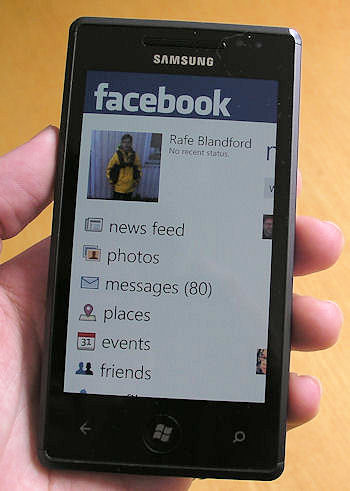
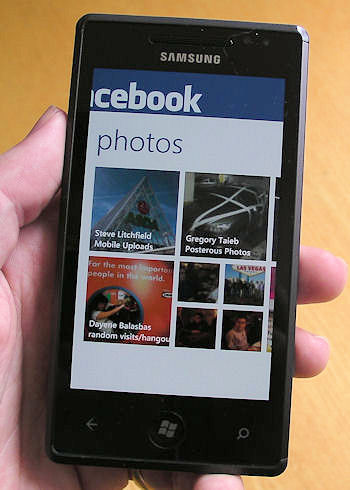
It's just that issue of speed again - multiplied by poor connectivity at the Conference. Back home, sitting next to my router, it was just about acceptable, but I'm noticing more and more that I'd ask the phone to do something, then look away, chat to someone, pick up a flyer, and only then look back at the screen to see if the operation was completed.
The thing here is that Windows Phone is currently aimed at the tech market, and that means every half-second of waiting for information is going to be crucified online. Looking back over the points above, I can see why. The simple answer is that Windows Phone, as it stands in the HTC 7 Trophy, is too slow for serious work on social networks. It does get the job done, albeit you need a bit of patience. If you've got lots on, such as I did when prowling an exhibition hall, then you won't notice too much, but if you're sitting on a bus or train, you'll get very used to the five dots flitting along the top of the screen showing that data is loading. This is pretty much the only feedback you're going to get for your internet connectivity, there's no info box telling you which connection the phone has started to use, there's no easy way to check which connection is in use... I've always been confident that I know what my phone is doing (I like that trait in Symbian) but Windows Phone requires a little bit more trust on my part, and that takes time.
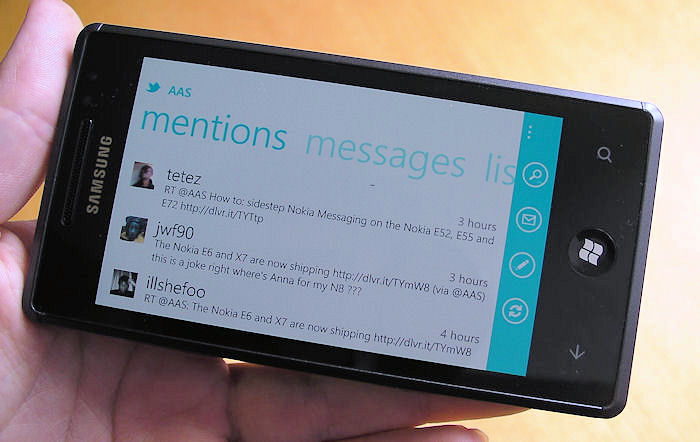
That's not the sort of thing you can gauge in a review over a day or two, you need to spend time with a phone to really get it, as I have been doing.
Naturally we'll return to these points when Nokia's Windows Phone units appear. Even as it stands, the social networking capabilities of Windows Phone out of the box are probably in a better place than those in Symbian and it's set to improve by the time said handsets hit the market. So I'm optimistic.
-- Ewan Spence, May 2011.
